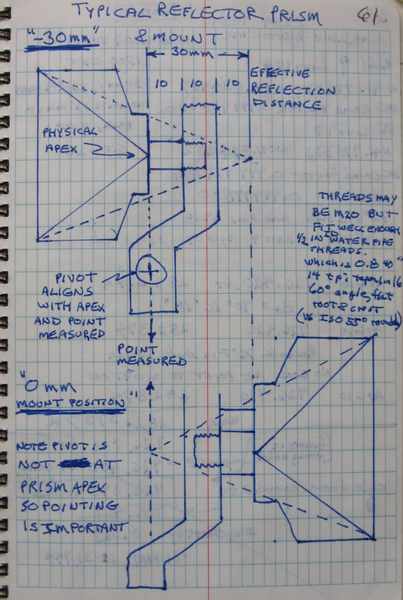What's the story behind the -30mm prism offset? Why do we do it. Why
I would believe it to be a tooling related find rather than by design.
When they created a 0 offset holder, the flipside was -30mm
0.02
I do not have "a pipeline to the truth", but I always figgered it was for balance.
A large-aperture prism with 0 offset is rather front-heavy.
Light travels slower in glass than in air so to get the effective reflective surface at the mounting axis means the glass has to be offset toward the instrument.
GB
-30 is close to the nodal point for a 60mm prism.
http://www.lasersurveyingequipment.com.au/technical-articles/nodal-prisms-explained
TJE Yogi, post: 367976, member: 963 wrote: What's the story behind the -30mm prism offset? Why do we do it. Why
I'm not an expert, but here's my favorite sketch explaining the difference, that that someone here (I can't remember who), posted.
At -30mm the apex of the prism is at the alignment point. In that case you can aim at the center of the prism and not be concerned with aligning the prism to the line of sight. (that apex does not move when the prism is rotated. The downside (if you can call it that), is that you must make sure to enter the prism constant into the DC, to be used in distance calcs.
At 0mm offset, you can't aim at the center of the prism but instead use the target which is at the rotation point plane. Then, prism alignment just doesn't matter. I like that there's no additional constant to keep track of.
How any of this matters with robotic guns or reflector less guns (if a prism is used with one), I have no idea.
It's because the back of the glass is 30mm behind the pivot point/rod tip. The total glass measures 60mm, with 30mm hanging in front of the tip, 30mm hanging over the back. Since the EDM measures to the back of the glass, you have a -30mm offset
rfc, post: 367987, member: 8882 wrote: At 0mm offset, you can't aim at the center of the prism
It's not just aiming for angle. The EDM will give a little error if the prism isn't aimed at the gun.
The critical thing isn't the back of the glass, but the effective reflection distance. Due to the index of refraction of the glass, the reflection time is longer and the EDM measures to a phantom point out behind the actual glass.
Bill93, post: 368085, member: 87 wrote: It's not just aiming for angle. The EDM will give a little error if the prism isn't aimed at the gun.
The critical thing isn't the back of the glass, but the effective reflection distance. Due to the index of refraction of the glass, the reflection time is longer and the EDM measures to a phantom point out behind the actual glass.
I can't remember who it was here that discussed this at length sometime ago (Conrad? MathTeacher?), but I think the errors induced by rotating the prism 20 to 30 degrees off axis are an order of magnitude lower than any others, including simple atmospheric conditions (through which the EDM waves are travelling the whole way (twice).
Some back of napkin numbers show that with a refractive index of glass of 1.5, the velocity through the prism drops to 200,000,000 m/sec. But if the total difference in length of travel through the glass is less than 10 mm or so as the prism is rotated say 20 degrees left or right of center, at 50mhz, that's less than .0008 cycles of difference. I don't think the phase shift measuring ability of the EDM goes there. The difference, as I recall, is simply not measurable on a typical total station (with a readout to 3 digits to the right of the decimal. I think there are probably Gigahertz frequency EDMs that can get down to micrometer regions, but I'd doubt even they could detect an additional 10 mm of travel through glass unless you did the whole thing in a vacuum.
Fun to think about though.
Topcon seem to have adopted 0 prism constant only for their traverse kits. I always wondered why as traditionally -30 would be considered the better of the two to use.




